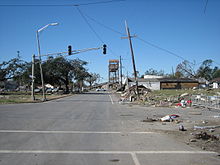- Claiborne Avenue
-
Claiborne Avenue is a major thoroughfare in New Orleans, Louisiana. It runs the length of the city, about 9.5 miles (15.3 km), beginning at the Jefferson Parish line and ending at the St. Bernard Parish line; the street continues in each of these locations under different names. It is called South Claiborne Avenue upriver from Canal Street and North Claiborne Avenue from Canal to St. Bernard Parish. It is named in honor of William C. C. Claiborne, the first United States governor of Louisiana.
Contents
Route description
Claiborne Avenue can be divided into three general sections as it winds through the city, following the curves of the Mississippi River.
The Crescent
For the first few miles in the city coming from Jefferson Parish, Claiborne Avenue is part of U.S. Highway 90; before crossing the parish line it is called Jefferson Highway. Highway 90 shifts to Broad Street as it meanders its way out of New Orleans toward Slidell, while Claiborne continues towards the Central Business District. The section from Jefferson Parish to the large interchange at Earhart Boulevard and Interstate 10 visibly follows the crescent in the river, from about a mile inland, that gives New Orleans its nickname. For this stretch, the street is six lanes, three in each direction, with a neutral ground in the middle. It passes through a mix of residential and commercial districts.
Through the Treme
The oldest section of Claiborne Avenue runs through the Treme neighborhood; in several phases there had been a street named for Governor Claiborne since the neighborhood was first developed in the early nineteenth century. The wide neutral ground was lined with live oak trees, and the public green space served as a center of congregation for the area's primariliy African-American residents. The Claiborne intersection at Orleans Avenue, in the heart of Treme, remains a primary meeting ground for the Mardi Gras Indians.
This stretch of Claiborne is primarily commercial, with residential neighborhoods throughout the adjacent blocks. It traditionally served as an important African-American shopping district, a counterweight to Canal Street, which catered to the white community. For three blocks, Claiborne also passes the old Saint Louis Cemetery #2 in this section.
 Claiborne Avenue, looking towards still closed bridge over the Industrial Canal after Hurricane Katrina
Claiborne Avenue, looking towards still closed bridge over the Industrial Canal after Hurricane Katrina
Overshadowed by I-10
One of the most controversial developments in New Orleans' history involved the construction of Interstate 10 through the Treme neighborhood as an elevated freeway above the oldest section of Claiborne Avenue in the late 1960s. The construction generally followed vacant land, such as the filled-in New Basin Canal. The original design called for the Interstate to be built along the river through the French Quarter. A successful campaign was organized by French Quarter residents and preservations to redirect that stretch of Interstate. The width of Claiborne Avenue provided the second most convenient route for construction, while still bringing the interstate very close to the Central Business District and the French Quarter, a few blocks from Claiborne. The opposition of the largely African-American and disenfranchised residents of Treme was not enough to stop the project from going forward. After construction, cement parking lots replaced the grassy neutral ground and supports for the interstate replaced the old oak trees, permanently changing the streetscape. It is commonly held that the construction of the overpass was intimately tied to the overall decline of the Treme neighborhood in the 60's and 70's[1]. As part of the 2002 "Restore the Oaks" program, some of the round supports were painted by various local artists, while others were painted to resemble oak trees.
In the wake of Hurricane Katrina, many have called for the removal of the I-10 Claiborne overpass, rerouting I-10 to the I-610 corridor. Suppoters cite the structure's need for costly repairs and damage it has caused and continues to cause to what could potentially be a thiving urban neighborhood. Opponents argue that the overpass' removal would cause great inconvenience to the residents of New Orleans East and potentially require unwanted and intrusive expansion of the I-610 corridor. The September 14th, 2009 draft of the New Orleans Master Plan calls for the study and eventual removal of the overpass[2].
Towards St. Bernard Parish
At St. Bernard Avenue (not to be confused with the parish), Claiborne and the Interstate part as the street continues to follow the river. It becomes a four-lane divided street, and then the eastbound (downriver) lanes separate from Claiborne to join North Robertson, a one-way street, through the upper Ninth Ward. At this point Claiborne Avenue is technically only the westbound side, a block away. The two rejoin at the Claiborne Avenue Bridge over the Industrial Canal, and the street continues through the Lower Ninth Ward to St. Bernard Parish, where it becomes Judge Perez Drive.
See also
- Famous streets of New Orleans
References
- Campanella, Richard. Time and Place in New Orleans: Past Geographies in the Present Day. Gretna, Louisiana: Pelican Publishing Company, 2002. See especially pp. 99-104. ISBN 1-56554-991-0
City of New Orleans Topics History · Geography · Demographics · Economy · Culture · Healthcare · Media · Music · Sports · Architecture · Tourism · Education · Notable people · Skyscrapers · Streetcars · Flag · Lists

Government Neighborhoods Wards: 1st · 2nd · 3rd · 4th · 5th · 6th · 7th · 8th · 9th · 10th · 11th · 12th · 13th · 14th · 15th · 16th · 17th Categories:- Streets in New Orleans, Louisiana
Wikimedia Foundation. 2010.



